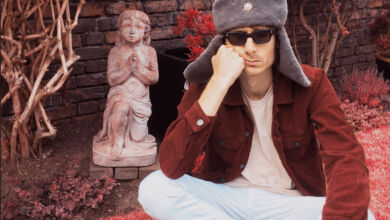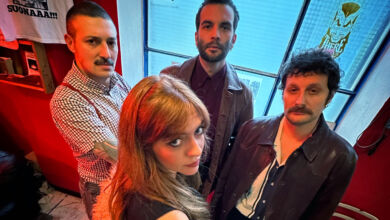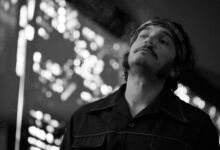
Warning: Undefined array key "layout" in /home/u430322976/domains/eyeplug.net/public_html/magazine/wp-content/plugins/wp-about-author/wp-about-author.php on line 94
I’ve just finished reading Adam Ant’s autobiography Stand and Deliver. It was very readable, if a bit repetitive at times; it’s horribly honest. It goes into Adam’s music, influences, early and family life, sex addiction, rootlessness – he bought several houses in several different places and was unable to face living in any of them for long, often returning to his tiny London flat – and loneliness, even as one of the most popular entertainers in the world. It also details his quest to get some acting roles that would match his success in pop music, his depression, his mental illness, and finally his several disorderly conduct arrests and sectioning in recent years. It ends on a relatively positive note. Adam is now back doing the circuit of small-to-medium gigs – the results are all over YouTube – and the odd (and often rather combative) interview in between living, until we hear differently, a quiet life.
Reading the book has prompted me to revisit my one-time love of Adam Ant’s music, though it never really died out. I was a fan of Adam and the Ants in the late 1970s, before his rise to phenomenal fame in 1980, in which he really did see off all the competition. I first saw the band on a bill at Soho’s Vortex Club in mid-1977, supporting my other fave band of the time, Siouxsie and the Banshees. I was blown away by the energy of the performance, and the manic, dangerous edge it brought to the atmosphere. The first line-up I saw featured Adam singing and playing guitar occasionally, Andy Warren on bass (a thin, gaunt figure described in Ants publicity as being called Winkle and Watson, for some reason), the handsome Dave Barbe on drums and a guy called Johnny Bivouac on guitar. What was it about Johnny Bivuouac I didn’t like? His hair was all wrong, I thought, sort of freeze-dried-looking, and he wore a cap-sleeved t-shirt, which was so sort of pre-punk disco. Was I shallow, or what? (Yes, I was.) Great guitar player, though.
Adam was beautiful, no other word for it. His hair wasn’t very punk, either, all Romany curls, and at least one of his eyes was often slathered in eyeliner – or he wore clear-framed National Health specs – his lips lipsticked black. He looked like a hyperactive mannequin, a crazed escapee from the Commedia dell-Arte – you know, Pierrot, Harlequin, medieval Italian Punch and Judy show. He was a New Romantic a few years before the movement he would later despise came into being. But I guess what made him beautiful, ultimately, was his sense of don’t-give-a-fuck-ness: that is always something fantastic to behold. On a more basic level, I also loved his skanky leather trousers, his strappy boots from Sex, or Seditionaries, as Westwood and McLaren had rechristened the shop, loved his bare torso when he got half his kit off, with its tattoos, scratches and bruises, its hint of puppy fat at one gig, his ribs showing starkly at the next.
A friend made a recording of this line-up from a gig at Oxford Street’s 100 Club, a ton-weight cassette player secreted round his waist, and the recording came out brilliantly; I was able to learn all the songs, obsessively working them out on my guitar in the right keys, finding, often to my dismay, that they weren’t always in the keys guitarists like – lazy ones, as I was then; Deutscher Girls started on D flat, FFS, a chord I’d barely heard of. My respect for Johnny Bivouac increased. This was to be important to me a year or so later, when Johnny left (or was dumped, actually – Adam already had a history of getting rid of band members on a whim, though I didn’t know that at the time) and, after seeing an ad in Melody Maker, just by chance, after an hour of getting over it I went to audition as a replacement. Because I’d been listening to the tape, I was able to turn up and just play the tunes. Adam asked me, “Do you know B-Side Baby?” and I went straight into the guitar intro as he was about to recite the chords, and also led the band into that Db chord starting their ode to mädchen-in-uniform Deutscher Girls. They were impressed. But they were more impressed by 17-year-old Matthew Ashman, who got the job instead of me, so there I went, back into obscurity for a few decades… Was I too ugly, too spotty, not punk enough – was my Rickenbacker guitar just not cool enough? But both Andy Warren on bass and first Ant guitarist Mark the Kid Ryan bashed Rickenbackers. Was it my hair, then, not enough gel, or too much? Or was I just a bit too porky for the stripey teeshirt I wore to the audition? (Not everybody can get away with horizontal stripes, but it was very similar to the one I now wear sometimes in the Trans-Siberian March Band.) No, none of those things, I hope. It was Matthew Ashman; he was pure class on a guitar, pure rock n roll, and I just wasn’t.
With the phenomenally talented Matthew, the Ants went on to a different phase, and a whole load of different songs, that culminated in the album, out on independent Do-It Records, Dirk Wears White Sox. None of the songs they played at the early gigs made their way onto that album; they only turned up later on bootlegs, or were revamped occasionally on slicked-up versions on the b-sides of some of the hit singles, once Adam was a star. Those early songs featured themes of S&M, sex in general, murder and Nazis, basically, though there was the rather sweet Send a Letter to Jordan (about Adam’s obsessive letter-writing to one Pamela Rooke, who worked in Malcolm McLaren and Vivienne Westwood’s King’s Road shop Sex), a cover of Perry Como’s Catch a Falling Star and the gentle French music hall pastiche of Young Parisians. Deutscher Girls, Nietzsche Baby and Dirk Wears White Sox (which ghosted only as a title on the Do-It album) all worked through fetishised pictures of Nazism; they poked fun at it, though this wasn’t always clear to the music press, who dismissed the Ants as a Nazi band at one point, despite their having a black drummer in Dave Barbe, and Adam being a descendant of British Roma. Il Duce described Mussolini as a ‘fatty fasciste – they call him the fat boy’ and had a derisory chorus of Santa Lucia in the middle of it, so it was sometimes difficult for Antpeople (as Adam dubbed us fans) to see how it could be taken as anything other than black comedy. The S&M songs included Beat My Guest, Whip in My Valise, Ligotage, You’re So Physical and Bathroom Function. There were other tunes, such as the subtle, slow Song for Ruth Ellis, which had the hook ‘Violence in Hampstead’, and a frenetic tune just called Hampstead, ‘a place for fairs and not for revolution – you’re deprived of being deprived’. There was Lou, known to fans as Andy Warhol Video from one of the few coherent lines in the chorus, a song about Lou Reed, the verses of which were screeched out by band manager at the time, Jordan – that same Pamela Rooke, from McLaren and Westwood’s Sex/Seditionaries boutique, and a big face on the early punk scene. There was also the comic, smutty Juanito the Bandito – ‘he’d even make love to a dog’ – and the rather grim Light Up a Beacon on a Puerto Rican, which dealt with racism, albeit in a rather repugnant and aggressive manner. A lot of people also missed the pure music hall-type humour of songs like Friends, basically a list of claimed friendship with famous people from all eras punchlined with the line ‘If I come on the night, can I get in free?’
In Derek Jarman’s film Jubilee, along with Deutscher Girls (shown briefly, on a background TV), the full version of the Ants’ gig-opening tune Plastic Surgery features. The film was a bit of a mess, but was worth seeing for this sequence alone, in which Adam threw himself into the performance with such zest that he dislocated his knee.
I must add that I think the tunes on Dirk Wears White Sox, with Matthew Ashman on guitar, are pretty good – I don’t want to give the impression that I didn’t like them at all. Animals and Men is surely the only tune ever written about Italian Futurism; Car Trouble Part 1 and Family of Noise arrived at punk-funk-disco years before the Red Hot Chillis. The Day I Met God (and was impressed ‘at the size of His knob’ – tch, really, Adam) is a sublime piece of on-the-road observation: ‘We was coming back in the van, from Milan, and I saw God, right there’. Like you do. Catholic Day, again, is a first, as far as I know, a song about JFK’s assassination, his ‘sporty young hairstyle’, his brain falling on Jackie’s knee on that day in Dallas. Never Trust a Man with Egg on His Face is a menacing piece of sci-fi. All good. But not the Ants I’d known, followed, recorded, learned, looked forward to. Serious twenty-something post-punk types like me, with our floppy fringes and long overcoats, and a bit up ourselves, were a pretty fucking hard-to-please bunch, I guess.
A lot of the early tunes are now available to hear on YouTube, accompanied mostly by still pictures, and often from dodgy live recordings, and consequently they’re a bit scrunchy, but they give a real flavour of the barrage of sound, and the innovative, and often chaotic, nature of early Ants performance, at a time when most 1977 bands were trying to be secondhand Sex Pistols, and intoning crap tunes about boredom, or being boringly ‘political, maaan’, in bad imitations of the Clash. Adam and his Ants were never as rock n roll as the Pistols, were never as doctrinaire as the Clash, were not as precious as the Banshees, nor as arty as Wire – I thought the Ants got it exactly right in having a decent mix of all those different elements.
Andy Warren went on to join The Monochrome Set – one of my favourite bands from the same period – while Dave Barbe and Matthew Ashman were stolen by the scheming Malcolm McLaren to back the 14 year-old Annabella Lu Win in his new project Bow Wow Wow. Adam had paid McLaren a grand for advice on the next phase of his career – “Do cowboys, Adam,” mockney Malkie said out of the corner of his mouth, “do Indians, mate, do pirates, swash your buckle, bit of flash, bit of brash, become a prince charming…” – so Adam didn’t come too badly out of the deal in the end.
Bow Wow Wow ploughed a similar furrow, sporting Vivienne Westwood’s new off-the-peg pirate look, with Dave Barbe stripped of his sharp and punky name and restored to Dave Barbarossa – the legendary Redbeard the Pirate. They played Burundi drums and Duane Eddy guitars, speedy fifteen-fingered basslines, tunes about corsairs and other planets, the Eiffel Tower as a phallic symbol. They released an album on a cassette, had Annabella photographed in the nude. They were great, but never quite the business, despite being talented, photogenic, controversial and newsworthy. What went wrong with them? For the mass market, the formula just didn’t work as well as Adam’s: he had it, and they didn’t.
Adam hooked up with Marco Pirroni, another man with a great pedigree on the punk scene, who’d been there from the beginning, wearing the shirts, playing the guitar, po-faced and workmanlike, canny enough to tell the shite from the shine. Marco was (and still is) a rare talent, and the best thing that happened to Adam – I’m sorry to hear they don’t talk anymore these days. I didn’t mind some of the tunes they had massive hits with – I liked some of the Kings of the Wild Frontier album, resigned myself to be exasperated and then amused to see that the line ‘Dirk Wears White Socks’ had gone from an entire song about comedy Nazis and slapstick Berlin decadence in 1977, to the somewhat meaningless (to all but original Antpeople, who were still rather mystified by it) title of a 1979 album, to an even more cryptic line in the chorus of an unmemorable 1980 non-tune, the weak Don’t Be Square be There. By the time Adam was standing and delivering and doing the Prince Charming two-step with Diana Dors, shaking hands with royalty and appearing on Jim’ll Fix It I thought it had all become a bit too cartoony. (In fact, several children’s mags did indeed feature cartoons in which Adam was the hero, totally messing up my metaphor here.) I can see that he never would have made it with the early tunes – Princess Margaret and her sis probably wouldn’t have tapped their feet along to any tune that went ‘Tie me up and beat me with a stick, beat me, beat me’ – and that Adam did what he had to do to become the world-famous song and dance man he craved to be, and turned into. I’m glad he made it, glad he became a name and a face, a look and a haircut and a style of his own: I’m glad he ‘sold out’ – as we Antpeople sniped for an inordinately long while – and got the fame he deserved for the hard work he put in. He paid a massive price for it in the end, unfortunately. I’m also glad his hidden legacy of early tunes is now around and available though, just as it ever was, you need to seek it out, though I’m too much of an ole fart these days to want to listen to the songs TOO often.
Many thanks too our guest writer: Nick Sweeney is a talented published Author and member of The Trans-Siberian March Band © 2015.








